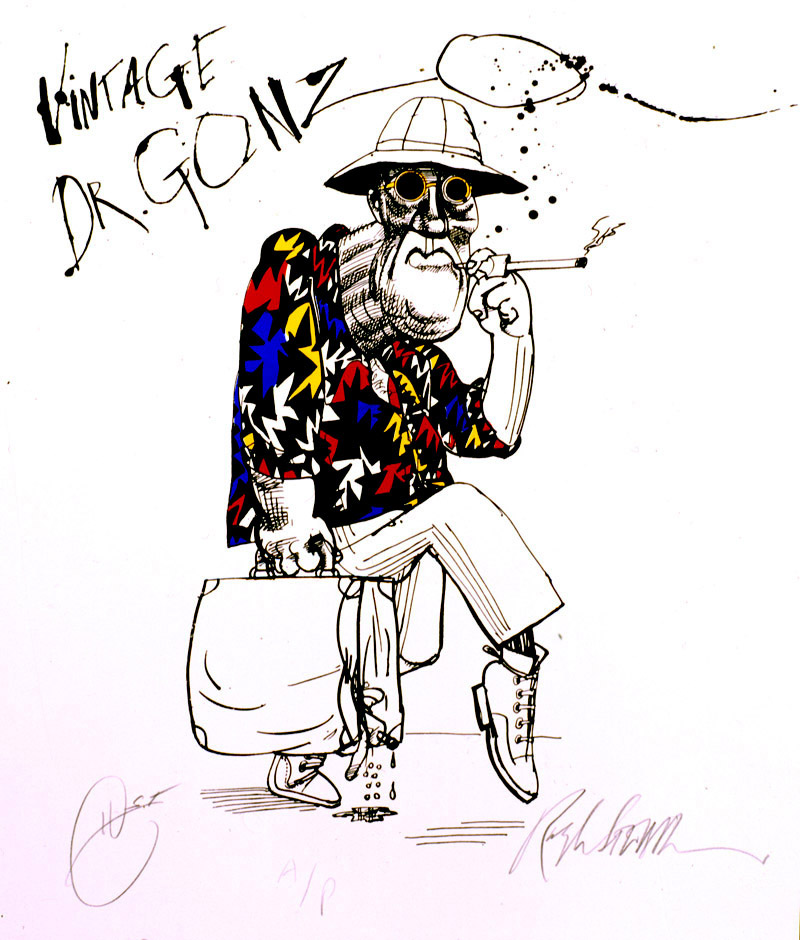I recently gave a talk at EGU called Vanishing Point: A Savage Journey to the Heart of the Scale Hierarchy (abstract here). The title is borrowed/inspired from the iconic 1971 movie Vanishing Point (director: Richard Sarafian) and the subtitle to Hunter S. Thompson’s 1971 Fear and Loathing in Las Vegas—A Savage Journey to the Heart of the American Dream.
The “vanishing point” terminology refers to methods to determine how far apart elements of a scale hierarchy have to be before they are no longer directly related. I attempted to justify the “savage journey” with the argument that the scale domain, as opposed to the spatial and temporal domain, is little explored and largely unknown.

Hunter S. Thompson, by Ralph Steadman (an illustrator who worked with HST; www.ralphsteadmanartcollection.com).
I submitted an article with the same title, with one reviewer unsurprisingly objecting to the (at least by scholarly standards) lurid title. He found the allusion to Thompson gratuitous (OK, it was, but HST is one of my heroes and I love a quirky title), and indicated that there was nothing journey-like about the paper (also fair enough). The referee also commented that the paper was hardly gonzo (the style of journalism Thompson pioneered). As freedictionary.com defines gonzo as “using an exaggerated, subjective style, as in journalism,” and all that is a no-no in science, I suppose that’s a good thing in some respects.
But it got me to wondering: Could there be such a thing as gonzo geomorphology? What would it look like?
First, to see who might have gotten there first, I looked up gonzo science, gonzo geography, and gonzo geology as well as gonzo geomorphology. Got a few hits, but nothing relevant to scientific research, or, as far as I could tell, to HST-style gonzo journalism (by the way, I would consider Denis Wood a gonzo geographer, though as far as I know he does not refer to himself as such).
But “gonzo ecology” was a different story. The Gonzo Ecology Blog by a Tasmanian biologist has not been updated since 2013, but the introduction would seem to apply to geomorphology as well as ecology:
"GONZO" - its the idea that the story of how you got the story is often more interesting than the story itself. Hunter S. Thompson coined the term as a journalist but the Gonzo philosophy seems highly appropriate for ecological fieldwork. While the end result may be research and conservation, the PROCESS of it all entails more than a fair share of adventure...
The posts seem to mainly live up to this, and provide some entertaining and useful insight to field ecology.
There is also a Gonzo Group doing ecosystem ecology at the University of Maryland’s Chesapeake Biological Laboratory. From the “how we got our name” section of their web site:
We've been calling ourselves The Gonzo Group for many years, mainly because it brings a smile to our sometimes stressed faces. It began in 1986 when several of us were reading Hunter S.Thompson's books and were highly amused by the characters and events portrayed. The notion we took away from these books was the idea of involvement in the action: Gonzo Journalism in the case of Thompson; and, in our case, involvment in many aspects of estuarine ecology including research, teaching, advisory services, and mainly enjoying what we do. Our general policy is to avoid the rasher aspects of Gonzo style, but moments do occur in small boats in bad weather with equipment that does not work where the notion of Gonzo helps get the job done.
Gonzo journalism is characterized by a lack of claims of objectivity, and the notion of the writer as part of the story. The gonzo style is energetic and participatory and may also make liberal use of sarcasm, exaggeration, humor, and slang (including profanity). This is NOT what we need in our standard, mainstream scientific communication, as it could lead too easily to the kind of relativistic morass that plagues much social science work—there is no true/false, wrong/right, or correct/incorrect, only competing socially constructed narratives. Might be fine for political ecology, but it’s not going to help us figure our glaciers or rivers or sand dunes.
However, a dose of gonzo might be just the thing for some of our research talks, teaching, and informal communications (blogs and such). Even if how you got the answer is less important than the answer itself, it may indeed be more interesting, and instructive to others seeking answers to similar problems (or to test or challenge the one you came up with).
So, I’m still not sure exactly what gonzo geomorphology would look like, but I’d sure like to see! I have previously cogitated/ranted on Jedi Geomorphology, Romantic Geomorphology and Badass Geomorphology—who knows what bizarre take will strike me next?
